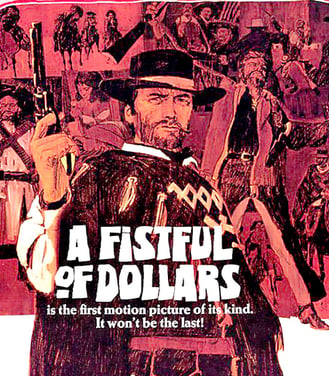A Fistful of Dollars: A Groundbreaking Spaghetti Western That Changed the Film Industry
Cinemapedia
Released in 1964, A Fistful of Dollars (Per un pugno di dollari) marked a pivotal moment in cinema, bringing the spaghetti western genre to the global stage. Directed by Sergio Leone and starring Clint Eastwood, the film captivated audiences and redefined the western genre, previously dominated by Hollywood. With its low-budget production, innovative visuals, and iconic characters, A Fistful of Dollars became a trailblazer in the spaghetti western genre, leaving an indelible mark on the world of filmmaking.
Synopsis
A Fistful of Dollars follows the story of a mysterious drifter (played by Clint Eastwood) who arrives in a small town on the Mexican border. The town is caught in a violent conflict between two rival criminal families—the Rojo family and the Baxter family. The drifter, later known as "The Man with No Name," sees an opportunity to exploit the situation for personal gain. Using his cunning, he manipulates both sides into a confrontation, all while seeking to restore some semblance of order to the town. The plot is heavily inspired by Akira Kurosawa's Japanese film Yojimbo but is adapted with a distinct western flair that sets it apart.
Revolutionizing the Spaghetti Western Genre
A Fistful of Dollars was one of the first films to introduce the concept of spaghetti westerns to international audiences. The term "spaghetti western" refers to western films produced in Italy during the 1960s and 1970s. These films were characterized by grittier tones, desolate settings, and morally ambiguous protagonists. Unlike Hollywood westerns, which often featured noble, heroic characters, spaghetti westerns explored darker and more complex themes.
Sergio Leone introduced fresh elements to A Fistful of Dollars, including an anti-hero protagonist and minimal yet impactful dialogue. The film also showcased a distinctive visual style, featuring extreme close-ups of characters' faces and sprawling shots of arid desert landscapes. This innovative approach quickly became a hallmark of Italian westerns, influencing filmmakers worldwide.
The Iconic "Man with No Name"
One of the most compelling aspects of A Fistful of Dollars is its central character, portrayed by Clint Eastwood. Known simply as "The Man with No Name," this enigmatic figure defies the typical western archetype. He is a stoic, cynical loner who isn’t afraid to resort to violence to achieve his goals. Beneath his cold demeanor, however, lies a personal code of ethics that adds depth to his character.
This anti-heroic portrayal redefined the western protagonist, offering a more nuanced and humanized depiction. Eastwood’s performance, complete with his signature poncho, cowboy hat, and cigar, cemented his status as a cinematic legend. His role in A Fistful of Dollars marked the beginning of his rise to fame as one of the most iconic actors in the western genre.
Stunning Visual Style and Cinematography
Sergio Leone masterfully crafted a unique atmosphere through his groundbreaking visual style. By employing intense close-ups of characters' faces and juxtaposing them with vast, barren desert landscapes, Leone captured the harsh and unforgiving environment of the Mexican border. The dramatic and contrasting cinematography heightened the tension and set A Fistful of Dollars apart from traditional Hollywood westerns.
Leone also made extensive use of montage sequences, creating long, dialogue-free scenes filled with expressive visuals. These sequences allowed viewers to immerse themselves in the emotions and situations of the characters without relying on words. This innovative technique became a defining feature of spaghetti westerns and influenced countless directors.
Legendary Soundtrack by Ennio Morricone
It’s impossible to discuss A Fistful of Dollars without highlighting its iconic score by Ennio Morricone. The music, featuring a mix of guitars, trumpets, and unconventional instruments, created an unforgettable atmosphere that perfectly complemented the film's gritty tone. The soundtrack not only enhanced the film's emotional depth but also became a cultural touchstone, with its main theme instantly recognizable worldwide.
Morricone’s approach to music was revolutionary for the western genre. Instead of grand, heroic themes, he opted for raw, tension-filled compositions that reflected the brutal world depicted in the film. His work on A Fistful of Dollars became the standard for spaghetti western soundtracks and remains one of the most celebrated film scores of all time.
A Lasting Legacy
The success of A Fistful of Dollars did more than just launch the spaghetti western genre; it also changed the way audiences perceived heroes and anti-heroes in cinema. The film paved the way for equally successful sequels, such as For a Few Dollars More and The Good, the Bad and the Ugly, both starring Clint Eastwood and directed by Sergio Leone. Together, these films became known as the "Dollars Trilogy" or "The Man with No Name Trilogy," solidifying their place as cinematic classics.
The influence of A Fistful of Dollars extends far beyond the western genre. Modern directors such as Quentin Tarantino and Robert Rodriguez have cited Sergio Leone's work as a major inspiration for their films. Leone’s innovative techniques demonstrated that a low-budget film could achieve monumental success with a strong vision and creative execution.
A Revolution in Filmmaking
A Fistful of Dollars is more than just a western—it’s a cinematic revolution. The film proved that the western genre could be reimagined with darker, more realistic tones and morally complex characters. With its iconic protagonist, captivating visual style, and unforgettable music, A Fistful of Dollars not only introduced the world to spaghetti westerns but also inspired a new generation of filmmakers.
For fans of westerns or anyone who appreciates films with gripping stories and layered characters, A Fistful of Dollars is a must-watch. This groundbreaking masterpiece offers not only entertainment but also a powerful reminder of how art can transform perspectives—even through the lens of a cowboy in the desert.


